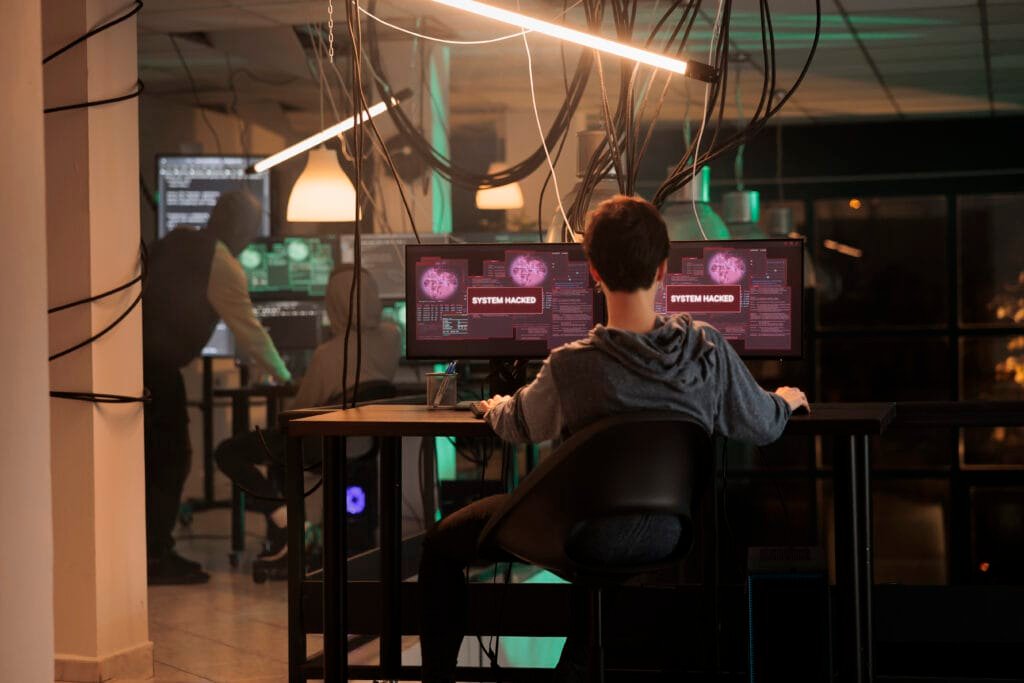Manufacturing Security Solutions- Safeguarding the Future of Production
In the busy world of manufacturing, where machines buzz and products start to take shape, there’s a hidden hero that’s just as important as all the physical parts: cybersecurity. This unseen protector works tirelessly behind the scenes, making sure everything in the factory runs smoothly without any hiccups. Nowadays, making stuff isn’t just about hard work and sweat; it’s about smart machines that talk to each other and learn. But, with all this smart tech talking to each other, there’s a bigger chance for trouble. Cyber dangers are around every corner, ready to mess up the flow of work and get their hands on secret data.
This is where security for manufacturing steps in, acting like a shield and sword in this new age of industry. These security steps are more than just putting up walls or installing antivirus software. It’s about building a strong, tough system that can see trouble coming, take a hit, and come back even stronger. It’s all about keeping the future of making things safe, making sure that as gadgets get smarter, security keeps up and moves forward together with them. So, let’s jump into the world of security for manufacturing, where every digital defense is a step toward a safer tomorrow in manufacturing.
Why Is Manufacturing Security Important?
Take a sneak peek into any modern factory, and you’ll see a complex dance of machines and technology keeping the wheels of production turning. But as the world of making things gets fancier with stuff like Internet-connected gadgets and smart AI, it’s also opened up a can of worms when it comes to digital dangers. These risks could throw a wrench in the works. That’s why keeping things secure in manufacturing is super important for you.
At its heart, keeping a factory secure is key for three big reasons: it keeps important secrets secure, makes sure production keeps humming along, and helps avoid losing money. Just picture the mess if a cyberattack messed up the plans for a new product or brought the whole production line to a grinding halt. The fallout would hit hard, not just on the money side of things but also on the company’s good name and how much customers trust them.
Also, in a time when factories are super connected, one small weak spot can cause a big problem, like knocking over a line of dominoes. Even though being connected can manufacturing work better and lead to new ideas, it also means there’s more at risk. Making sure factories are secure isn’t just about protecting against attacks; it’s about actively building a strong future for manufacturing. It’s about turning weak spots into strong points, making sure that as the world of manufacturing grows, it stays one step ahead of troublemakers.
Manufacturing Security Solutions

Manufacturing Security Solutions
Looking into the tools for keeping factories secure is like finding a treasure chest full of digital armor, each piece made to strengthen the world of modern manufacturing. These tools aren’t all the same; they’re specially made to meet the specific needs and tricky parts of the manufacturing world. From the first line of defense to the deepest parts where important data is kept, these tools work together to build a strong shield.
Leading the charge are things like firewalls and systems that spot intruders, acting like watchful guards against uninvited guests. But the protection doesn’t end at the entrance. Inside, secret codes make sure that even if someone grabs the data, they can’t understand it. Plus, secure ways to get in and systems that check who you are make sure only the right folks can move through this world, adding an extra layer of trust and sharpness.
But it’s not all about putting up walls; it’s also about being smart and quick on your feet. Fancy tools like SIEM (that’s a system that keeps an eye on security data and what’s happening) and smart AI that spots threats are always watching, ready to spot trouble before it starts. This smart way of doing things is backed up by regular checks and tests, kind of like practice runs to make sure everyone’s ready for any real attacks.
In short, the tools that keep factories secure are like the heroes of the digital world, mixing strength and smarts to protect, find, and deal with dangers. They make sure the machinery of making stuff keeps humming along, secure from the sneaky risks hiding in the digital shadows.
Overcoming Manufacturing Cybersecurity Challenges
Getting through the tricky world of factory cybersecurity is a big task for us. This area has its tough challenges, each one bigger than the last. From the huge, complicated setup of factory networks to the constantly changing and getting smarter cyber threats, the obstacles might seem too big to get over. But there’s an old saying, “Where there’s a will, there’s a way.” To beat these challenges, you need a mix of new ideas, always being on the lookout, and the ability to change when needed.
The biggest thing to tackle is just how big and complex the factory systems are. With so many different gadgets, ways of communicating, and old systems all tangled up in making things, making sure everything is secure can feel like trying to solve a puzzle with a blindfold on. The trick is to use solutions that cover everything well, making sure there’s no space for threats to sneak in.
Then, there’s the challenge of keeping up with cybercriminals, who are as clever as they are non-stop. As they get better at what they do, our defenses need to get better too. This means always learning and training, turning people from being the weak spot to being a strong wall of defense. Keeping everything up-to-date, fixing problems fast, and using the latest security tech means our protection is always top-notch, even as the attacks change and get trickier.
But maybe the biggest task is making cybersecurity a core part of how factories work. It’s about changing the way we think, from seeing security as just an extra thing or something we think about later, to something that’s a key part of everything we do. This big change in attitude, along with always checking for risks and dealing with them, sets us up not just to get by when cybersecurity issues come up, but to do well.
In short, dealing with cybersecurity in manufacturing isn’t just about reaching one goal. It’s about creating a security-first culture that’s a part of everything in the company, always ready to change, grow, and stand strong against the storms of the digital world.
Role of Automation in Enhancing Security

Role of Automation
In the big world of factory security, automation is the main star, changing the game with its quick, precise, and smart ways. The old days of just watching things by hand and only reacting when something goes wrong are gone. Now, automation is a key player, changing how security fits into the whole process of manufacturing.
At its core, automation means things are watched and taken care of all the time, like a guard that never gets tired. With automatic security rules, the system can spot anything odd right away, from a tiny change in how data moves to someone trying to get in who shouldn’t. This quick action is super important in a place where waiting even a little bit can cause big problems and mess-ups.
But automation does more than just spot problems. It also makes the huge job of handling complex security tasks much easier, smoothing out things like fixing software, putting in updates, and checking for weak spots. Picture a situation where, instead of rushing to fix thousands of gadgets by hand, an automatic system sends out the needed updates everywhere, right on time, making sure that defenses are always strong.
Plus, automation brings a steady and reliable touch to security that might be hard to get with just people working on it. It cuts out the chances of making mistakes that can happen with manual work, making sure security rules are followed the same way every time, with no misses or gaps.
Looking at the big picture, automation boosts the power of security in making things. It helps companies build tougher defenses, react to dangers super fast, and always be on the lookout. As we move forward into the future of making things, the part automation plays in making security better is not just helpful; it’s necessary, leading the way to a safer and more secure way of making things.
The Importance of Zero-Trust Infrastructure
In the changing story of how we keep manufacturing secure, the idea of a “zero-trust” setup has become important, changing how we think about keeping things secure. In the old days, if you were inside the network, you were usually trusted. But zero-trust turns this idea on its head. It’s all about not taking anything for granted and checking everything carefully. This change isn’t just a fad; it’s a crucial move because of the tricky and complex dangers that modern things face.
A zero-trust setup assumes that dangers could come from anywhere outside the network or even from inside. So, it looks at every single request to access the system as if it might be dangerous, no matter where it comes from. This way of doing things makes a lot of sense in places where we make stuff, especially now that we’re working with outside companies, letting people log in from far away, and using loads of internet-connected gadgets that make the old network edges fuzzy.
Implementing a zero-trust model in place means being very strict about checking who someone is, using things like multi-step checks to make sure it’s them, and making sure they can only get to the parts of the network they’re supposed to. It’s all about keeping the possible danger as small as possible and making sure that if someone does get in, they can’t do much harm because they’re only allowed to access the bare minimum they need for their job.
Also, zero-trust uses smart tech like breaking the network into little secure areas. This way, if attackers do get through the first line of defense, they can’t go wherever they want inside the network. They’re stuck in a small area, which helps keep the problem from getting bigger and causing a lot of damage.
Adopting a zero-trust approach is more than just getting new technology; it’s about completely changing how you think about keeping things secure. Companies need to stay ahead of the game, always checking and double-checking their security, even inside their systems. Think of it like a big game of chess where every move matters. Zero-trust helps you play smarter, making sure every part of your setup is secure and sound, ready to face any hidden challenges that might come up as technology keeps moving forward.
Safety Improvement Ideas

Safety Improvement Ideas
In the detailed world of manufacturing, where everything needs to be just right and every part is important for us, manufacturing safer is a must-do, not just a nice-to-have. As we dive into the world of keeping data secure and making sure operations run smoothly, there are lots of great ideas waiting to be discovered, all aimed at making the manufacturing world a safer place.
A key idea is using smart analytics to look ahead. With the help of data, factories can see potential safety issues before they even happen. This kind of heads-up means they can stop accidents before they start, making the workplace much safer. Picture machines giving a heads-up to workers about possible breakdowns or systems that can spot and stop dangers as they come up.
Another big idea is about empowering workers to know their stuff when it comes to staying secure. Learning is a super strong tool for security. When workers know all about the dangers online, how to keep things secure at work, and what to do in emergencies, they become security superheroes instead of weak spots.
Using security gadgets you can wear is another smart move. These gadgets have sensors that can check the air and keep an eye on health signs, and they can even warn workers if something dangerous is about to happen. In places where every moment matters, this kind of tech can stop bad situations from getting worse.
Creating a security-first kind of place, where everyone listens and every worry is important, is key to getting better at security. When people feel okay to speak up and share what’s on their minds, it builds trust and can bring out risks that no one might have seen before.
All in all, making manufacturing safer is about mixing tech, teaching, and a culture that cares about safety. By taking these steps, factories can create a safer tomorrow, where being secure is part of who they are, not just something they have to do.
Case Studies
Looking closely at stories from real companies in the manufacturing world gives us some great lessons. It shows us the tough spots they’ve hit and how they’ve managed to get past them. These stories aren’t just warnings; they’re also shining examples of smart thinking and the ability to bounce back that the manufacturing world has.
Take, for example, the story of a big car maker that got hit by a tricky computer virus. This virus messed up their assembly lines, causing them to stop working, which cost them a lot of time and money. To fix this, the company changed its approach to keeping its computer systems secure. They set up a super strict security system where they don’t trust any computer or person without checking them out first. They also made their computer defenses stronger and started teaching their workers how to spot and avoid computer threats. After all this, the company didn’t just recover; it became a role model for how to keep things secure in the industry.
Another story comes from a big drug company that was always worrying about keeping its special recipes and important information secure from sneaky thieves. They started using tough codes to lock up their data and made sure only certain people could get into their most secret files. They also set up a fancy system that watches over their computer network all the time, so they could spot trouble right away and deal with it fast. This made sure that their important discoveries stayed safe.
Then, there’s a story about a factory that makes clothes but was having a hard time with things not running smoothly and people getting hurt. They decided to bring in some smart tech, like gadgets that could talk to each other and automatic security checks, which helped things get better. They could now spot problems with their machines before anything went wrong, making the place safer and the work go faster.
These stories show us different ways to keep manufacturing secure and sound. Some used the latest gadgets, while others made sure everyone knew how to be careful and keep an eye out for danger. Every tale teaches us that being alert, coming up with new ideas, and staying strong is key to protecting the way we make things.
In conclusion
In the world of manufacturing today, where new ideas mix with old ways and machines work alongside people, keeping everything secure is super important for us, but also pretty tricky. We’ve looked at a lot of different parts of keeping factories secure, from making sure we have strong protection to using smart automation and not trusting anything without checking it first, all backed up by stories from real life. What we see is a story of being strong, able to change, and always being on the lookout. Keeping our factories secure is a journey that’s always moving forward, filled with both hurdles and chances to get better. If we use the latest technology and make sure everyone’s thinking about security all the time, we can not only deal with the dangers that keep changing but also do well. This is about more than just avoiding trouble today; it’s about making a future where making things is secure and works better, pushing us all ahead.
FAQs
How do manufacturing security solutions mitigate cyber threats?
Manufacturing security solutions employ a range of measures, including robust firewalls, encryption protocols, and real-time monitoring systems to detect and prevent cyberattacks. These solutions also often involve regular security audits and updates to stay ahead of evolving threats.
What role does employee training play in ensuring manufacturing security?
Employee training is crucial in creating a vigilant workforce that understands security protocols and can identify potential risks. Training programs educate employees about cybersecurity best practices, phishing awareness, and the importance of adhering to security policies, significantly reducing the likelihood of human errors that could lead to security breaches.
Are there affordable options for small-scale manufacturers to implement security solutions?
Yes, there are cost-effective security solutions tailored for small-scale manufacturers. These options often include scalable systems that can be customized to fit specific needs and budgets. Cloud-based security services and subscription-based models also provide affordable alternatives for smaller businesses.
How do predictive analytics contribute to enhancing manufacturing security?
Predictive analytics in manufacturing security utilize advanced algorithms to analyze historical data, identify patterns, and predict potential security threats before they occur. This proactive approach enables preemptive measures to be taken, reducing vulnerabilities and enhancing overall security.
What are the future challenges anticipated in manufacturing security solutions?
Future challenges in manufacturing security may include the integration of emerging technologies like AI, IoT, and blockchain into cohesive security frameworks. Additionally, keeping pace with evolving cyber threats and ensuring seamless compatibility among various security systems may pose ongoing challenges for manufacturers.








One Comment